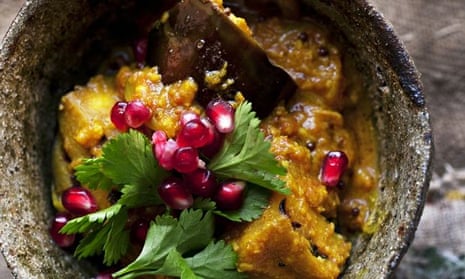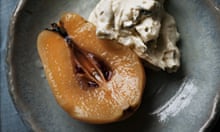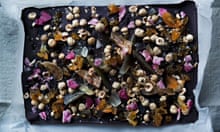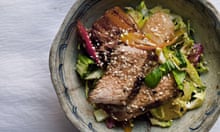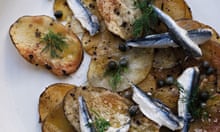I generally mix my own green-curry pastes, be they Thai or Vietnamese. I like the vibrancy that comes from the freshly blitzed lemongrass, ginger, garlic and coriander leaves. I successfully introduce the salty, sour notes using a spoonful of seriously aromatic shrimp paste and some fish sauce. My paste also gets the merest pinch of sugar if it needs it, something British cooks are often reluctant to do.
However I often buy the red-curry pastes ready made. Lacking the handfuls of fresh coriander that go into their green cousins, they usually have more heat and earthy depth. If I use ready-made pastes at all, then it will be the red. This week I visited a Thai grocer’s, stocking up on my favourite brands of both fish and chilli sauces, shrimp paste and palm sugar. I bought three sachets of ready-mixed red-spice paste.
Back at home I add some of the paste to a little gently sizzling oil and I can immediately smell that it is hotter than my homemade efforts (red chillies, lemongrass, ginger, lime zest, coriander roots, shallots and garlic blitzed in the processor). My eyes sting as the steam rises. The sourness that is so much part of the red curries of Thailand is more pronounced than it is in my homemade version, and somehow more reminiscent of the curries I have eaten in Chiang Mai.
During this evening’s cooking I decide to have a go at a Thai-style red curry with some duck legs I picked up at the butcher’s. I could have used chicken. I like the effect that the sweet coconut milk and hot spice paste have on the dark, sweet meat of the duck and its fat. The meat takes the extra hot spices well and the richness of the meat means that you don’t need a large amount to satisfy, one leg being quite enough for each person. Rather than adding noodles to this, as I usually do, I introduce a fistful of thin-stemmed broccoli, and no thickening, keeping the duck in a pool of rust-coloured, tongue-tingling broth for which we all need soup spoons.
Later on in the week I make a vegetable-based curry, bright with tomatoes and aubergines. No real paste here, just a sweet onion base with a casual spicing of turmeric, cinnamon, mustard seed and ginger. I use no chilli at all, leaving the warmth to come from the mustard seeds and ginger. The sauce is thick enough that we can mop it up with soft cushions of toasted flat bread.
Thai duck curry
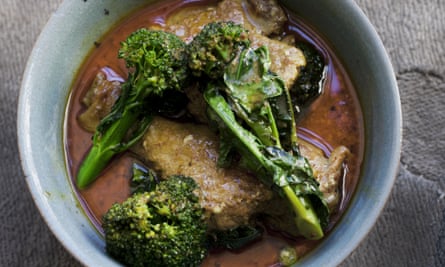
If you don’t want to use duck, chicken legs will work well, too. This is deliciously soupy in consistency, so provide everyone with spoons as well as knives and forks.
Serves 2
groundnut oil 1 t bsp
duck legs 4 pieces (2 whole legs)
red Thai curry paste 2 tbsp
curry powder 2 tsp
chicken stock 250ml
coconut milk 400ml
Thai or Vietnamese fish sauce 2 tsp
lime juice 1 tbsp, to taste
palm or caster sugar a good pinch
tenderstem broccoli 200g
Cut each of the duck legs into two to give four pieces, then season with a little black pepper and some salt. Warm the oil in a deep casserole then add the duck pieces and let them brown to a pale honey colour on all sides.
Add the Thai curry paste to the duck, stir over a low to medium heat for a couple of minutes, then add the curry powder and then the chicken stock and coconut milk and bring to the boil. As soon as the stock and coconut milk come to the boil, lower the heat so the duck simmers gently, cover with a lid and leave for about 20 minutes, until the duck is tender.
Stir in the fish sauce, the lime juice and palm sugar to taste. Trim the long-stemmed broccoli and cut into short lengths. Add to the pan and continue simmering for 4 or 5 minutes until the broccoli is tender but still retains a little crispness in the stalks.
Tomato and aubergine curry
A mild, fresh curry good for scooping up with flat breads.
Serves 2
onions 2 medium
oil 3 tbsp
coriander 1 tsp, ground
cinnamon 2 tsp, ground
black mustard seeds 2 tsp
turmeric 2 tsp, ground
tomatoes 4, medium to large
ginger 65g
garlic 4 cloves
aubergine 1 large or 2 smaller ones
coriander a handful of leaves
pomegranate seeds of a small one
Peel the onions, roughly chop them, then leave to cook in the oil in a deep, heavy-based pan over a moderate heat. Stir them regularly so they don’t burn, letting them soften and turn pale gold in colour. Add the ground coriander, cinnamon, mustard seeds and turmeric, stir, and then continue cooking.
Meanwhile, put the tomatoes, chopped but unpeeled, into a blender or food processor with the ginger and the peeled cloves of garlic. Process to a thick purée then pour into the onions, stir and continue to simmer gently.
Slice the aubergine in half lengthways, then in half again and then into short lengths. Warm a griddle pan and let the aubergine pieces cook until they are soft and lightly charred in neat lines on all sides. Gently fold the aubergines into the tomato and onion and continue to cook for a few minutes, correcting the seasoning with salt.
Spoon into bowls or on to plates and serve with coriander leaves and pomegranate seeds.
Email Nigel at nigel.slater@observer.co.uk or visit theguardian.com/profile/nigelslater for all his recipes in one place. Follow Nigel on Twitter @NigelSlater
